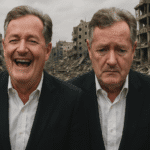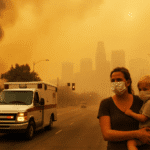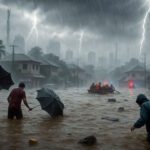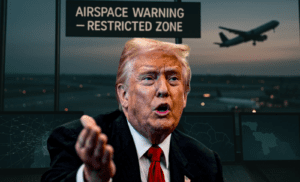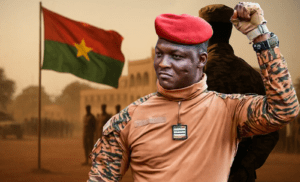by: The Washington Eye
The deployment of 2,000 National Guard troops to Los Angeles without the consent of California Governor Gavin Newsom, combined with the announcement of a massive Trump birthday military parade scheduled for June 14, 2025, marks a sharp turn in American political theater. These events are not isolated acts of crisis management or celebratory tradition; they are carefully orchestrated signals aimed at reframing national identity, recasting federal power, and consolidating personal authority through spectacle.
In a deeply polarized nation, where immigration enforcement ignites street-level unrest and presidential displays mirror military parades of autocratic regimes, a dangerous pattern is emerging: political messaging, once confined to press conferences and slogans, is now expressed through troop movements, arrests, and symbolic domination of space. This is messaging not through words—but through force.
From Protest to Occupation: California as a Stage
The recent clashes in Los Angeles began in response to aggressive ICE raids in immigrant-heavy neighborhoods such as Compton and Paramount. Community groups and legal observers allege that federal agents targeted day laborers and family-run shops without warrants, leading to spontaneous protests. As tensions escalated, demonstrators lit self-driving vehicles ablaze, blockaded the I-110 freeway, and clashed with heavily armed local police. In the past, such unrest might have prompted a state-level response coordinated through the governor’s office.
But this time was different.
President Donald Trump’s unilateral deployment of National Guard troops—under Title 10 authority—marked a constitutional provocation. Governors have historically had final say over their state’s National Guard unless federalized under extreme conditions. To override Newsom’s refusal, the White House cited an “ongoing failure to maintain civil order” and invoked “federal interests in immigration and national security.”
Legal scholars were quick to criticize the move as an abuse of executive power, with comparisons drawn to President Eisenhower’s 1957 intervention in Little Rock, Arkansas. But while Eisenhower sent troops to uphold civil rights and enforce desegregation orders, Trump’s rationale was the opposite: to suppress civil dissent sparked by federal overreach.
Parading Power: A President and His Army
Against this backdrop of civil unrest, the Trump administration announced a birthday parade for the president, planned for June 14, 2025—Flag Day. Reports suggest more than 6,000 troops, 150 armored vehicles, and over 50 military aircraft will be involved. Nominally organized to “honor veterans and American values,” the spectacle seems less about national unity and more about personal glorification.
This is not without precedent. Authoritarian regimes have long used militarized displays to build personality cults. From Mussolini’s march-pasts in Rome to Stalin’s Victory Day parades, such events serve two functions: first, to affirm loyalty within the ranks; second, to imprint a leader’s strength on the public psyche. In Nazi Germany, Hitler’s birthday parades were staged events where state loyalty and personal allegiance converged—spectacle became symbolism.
While it would be intellectually dishonest to claim America has become a dictatorship, the optics of Trump’s parade draw worrying parallels. When a head of state leverages military might for personal celebration, it crosses a psychological threshold in democratic governance. It suggests not “I serve the nation,” but “the nation serves me.”
The Convergence of Immigration, Protest, and Militarism
The deployment of troops in California and the parade in Washington are linked not just by timing, but by message: America’s enemies are internal, and control requires visible power. This aligns with broader trends under Trump’s second administration, particularly around immigration policy. Mass detentions, expedited deportation programs, and harsh enforcement have become routine. But they’re also media performances.
The ICE raids in Los Angeles weren’t discreet operations—they were made public almost immediately. Leaked footage of federal agents storming apartment complexes circulated on pro-Trump platforms before civil rights lawyers could respond. The message was clear: chaos in blue states justifies federal intervention.
This is political messaging through law enforcement. The police become narrative agents. Immigrants become abstracted into “threats.” And protests, even when peaceful, are recast as insurgency. By controlling both the cause and the response, the federal government controls the national conversation.
Psychological Theater: Governing by Spectacle
Political theorist Sheldon Wolin once described “inverted totalitarianism” as a system where corporate and state interests merge not to enforce submission through fear, but through managed spectacle. The citizen becomes a passive consumer of state images, rather than an active participant in civic discourse. The recent events in Los Angeles, paired with the Trump birthday parade, evoke precisely this: spectacle as governance.
The visual architecture of tanks on city streets, of riot police on freeways, of flags fluttering behind uniformed troops marching to a tune of patriotic nostalgia—these are not accidental visuals. They are engineered moments of reassurance to one part of the electorate, and a chilling warning to the rest.
Trump understands, perhaps better than any American politician in the modern era, that power today is performative. The border wall, whether completed or not, was less a physical barrier than a symbolic one. The same applies to the parade. It’s not about honoring veterans. It’s about staging control.
Historical Reflections: Is This a Turning Point?
America has seen domestic military deployments before—from the 1992 Los Angeles riots to Hurricane Katrina. But those were typically reactive and collaborative with state authorities. The current moment feels different. It’s pre-emptive, centralized, and layered with ideological intent.
Historians will no doubt compare this moment to earlier democratic backslides elsewhere. In 1930s Germany, legal mechanisms were used to centralize power gradually—each one seemingly justified by crisis. The military was folded into civilian life not through coup, but celebration. Flags, marches, slogans—they became the language of transformation.
We are not there yet. But the direction of travel matters.
When a president can deploy troops against a state’s will, host a militarized birthday parade, and rewrite unrest as insurrection—all while polling higher with a base that views these actions as “strength”—then the foundational principles of federalism, civilian control of the military, and political pluralism are strained.
Where Do We Go From Here?
Political messaging is not inherently dangerous. All governments engage in it. But when it’s done through uniformed force, mass detentions, and tightly choreographed pageantry, it becomes something else entirely: governance through theater, control through performance.
For citizens and institutions that still value liberal democracy, the challenge is twofold: resist the normalization of militarized politics, and reclaim the national narrative from those who equate strength with submission. That means empowering local governments, strengthening independent media, and ensuring the courts remain bastions of constitutional checks.
Because if power continues to be performed rather than questioned, we may one day look back at these parades and deployments not as outliers—but as turning points.



